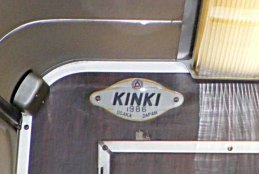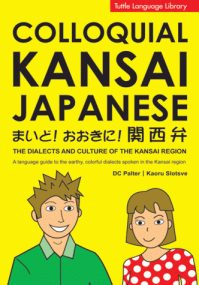An upcoming trip to Alabama has me thinking about “dialects”, and it’s a chance to give away a unique little Tuttle book called Colloquial Kansai Japanese: The Dialects and Culture of the Kansai Region.
A word about “Kansai”. The name (関西) means “Barrier-West” and refers to the region west of a checkpoint (“barrier”) where tolls were once taken. To the west of the barrier are Japan’s old capital, Kyōto, my favorite Japanese city, Ōsaka, and the modern seaport of Kobe. The “Barrier-East” (“Kantō”, 関東) region comprises Tōkyō and its surrounding cities.
A name synonymous with Kansai is “Kinki” (近畿), which means “Near-Capital”. Riders of Boston’s T may recognize “Kinki” from metal plates found in old Green Line trolleys (see photo) manufactured in Ōsaka. Alas, a homophone of English “kinky”, “Kinki” is slipping out of use. When the lavish, high-tech Kansai International Airport opened in ’94, officials knew very well not to name it “the Kinki International Airport”.
The word for “Japanese” in Japanese is nihongo (日本語), which means Japan-language. Within nihongo, speakers distinguish hyōjungo (標準語, “standard language”) from various hōgen (方言), which means “place-language” but is usually translated (as the same characters are in Chinese) “dialect”. Dialects themselves are referred to by their place name plus the character -弁 (-ben). The designation of dialects is totally flexible. Our book about Colloquial Kansai Japanese is about 関西弁 (the kanji are on the jacket). When speaking Japanese, however, you can refer to Ōsaka-ben or Kyōto-ben or Akita-ben or wherever you are. Just add -弁 to any place name. If you’re from Alabama, you can tell people you speak “Alabama-ben” (アラバマ弁).
The differences between “standard Japanese” and dialects of Japanese are not at all the same as the differences between variations of English. Varieties of English show a great diversity in pronunciation, especially vowels. I’ll be traveling from a region of the US where “bother” doesn’t rhyme with “father”, but “cot” sounds like “caught”. In Alabama, the situation is reversed.
In all Japanese dialects, the vowels are the same a, i, u, e, and o. There’s no variation. However, in Kansai-ben, the bulk of Japanese vocabulary is the same, but many of the fundamental words (the English equivalents of, for example, “is”, “good”, “bad”, and “not”) are different. The good news for aspiring speakers of Kansai-ben, then, is that switching out a short list of high-frequency words will get you speaking passable Kansai-ben almost immediately. Our book starts with a chapter titled “15 Words Needed to Survive in Kansai”. Even a beginning student of Japanese can make the switch quite easily.
That said, Kansai-ben, especially, I think, Ōsaka-ben, is spoken with a roudy joie de vivre embodied most in fans of Ōsaka’s baseball team, the Hanshin Tigers. They’re Japan’s lovable but usually losing equivalent of the Chicago Cubs. A post-game izakaya would provide the best room full of teachers anywhere. If you’d like to win this book, click here to email me and write “Kansai-ben” in the subject line. I’ll announce a winner next Wednesday.


